
About UsThe Numismatic Bibliomania Society is a non-profit organization devoted to the study and enjoyment of numismatic literature. For more information please see our web site at coinbooks.org SubscriptionsThose wishing to become new E-Sylum subscribers (or wishing to Unsubscribe) can go to the following web page link MembershipThere is a membership application available on the web site Membership Application To join, print the application and return it with your check to the address printed on the application. Membership is only $20 to addresses in the U.S., $25 for First Class mail, and $30 elsewhere. For those without web access, write to: David M. Sundman, Treasurer
AsylumFor Asylum mailing address changes and other membership questions, contact David at this email address: dsundman@LittletonCoin.com SubmissionsTo submit items for publication in The E-Sylum, just Reply to this message, or write to the Editor at this address: whomren@gmail.com BUY THE BOOK BEFORE THE COIN |
- WAYNE'S WORDS: THE E-SYLUM JANUARY 25, 2015
- LITERATURE IN BALDWIN'S WINTER 2014-15 LIST
- STOCKLEY OFFERS DISCOUNT ON BUSINESS AND BANKING BOOKS
- BOOK REVIEW: SEA OF DARKNESS
- NUMISMATIST ISSUES SOUGHT FOR DIGITIZATION
- FOOD STAMP CHANGE TOKEN INFORMATION SOUGHT
- STANDING LIBERTY QUARTERS AUTHOR CLINE DIES
- SUSAN GAMBLE, 1957-2015
- NOTES FROM E-SYLUM READERS: JANUARY 25, 2015
- 19TH-CENTURY NUMISMATIST WARREN GEE
- WANTED: A MEDALLIC VISUAL DICTIONARY
- 2015 HIGH RELIEF GOLD COIN DESIGN CANDIDATES
- INDIAN PEACE MEDALS IN STACK'S BOWERS 2015 AMERICANA SALE
- BAKELITE "MOHAWK" ENCASED LIBERTY NICKEL
- CONTEMPORARY COUNTERFEIT COINS
- A 3D-PRINTED COUNTERFEIT DETECTOR
- SELECTIONS FROM THE GOLDBERG JANUARY 2015 SALE
- SOME HAWAIIAN MEDALS AND TOKENS
- SELECTIONS FROM THE HAYDEN JANUARY 25 2015 SALE
- SELECTIONS FROM THE JANUARY 2015 KÜNKER BERLIN AUCTION
- ANCIENT COINS RETURNED TO GREECE FROM GERMANY
- COUNTERFEITS OF 200,000 DONG VIETNAMESE BANKNOTES
- HOW HOLLYWOOD MAKES ITS MILLIONS (IN PROP MONEY)
- MONEY LAUNDERING: NEW MACHINE CLEANS BANKNOTES
- FAMILIES REUNITE WWI SOLDERS' MEDALS
- COIN COMMEMORATES POPE'S VISIT TO SRI LANKA
- THE COIN BUSINESS: ADAPT OR DIE
- SHIP'S COINS DELIVERED BY BUTLER IN A ROLLS-ROYCE
- KAMPMANN JOINS BERMANIAN GUILD OF NUMISMATISTS
- ORIGAMI FISH MADE FROM A DOLLAR BILL
- FEATURED WEB SITE: PAPER CURRENCY OF CHIHUAHUA
Click here to access the complete archive
To comment or submit articles, reply to whomren@gmail.com
WAYNE'S WORDS: THE E-SYLUM JANUARY 25, 2015

New subscribers this week include: David Gottfried and Owen Linzmayer. Welcome aboard! We now have 1,816 subscribers.
Many thanks to the anonymous E-Sylum reader who coined a new catchphrase for us this week: The E-Sylum is E-Ssential to the field of numismatics!"
This week we open with two numismatic literature fixed price lists, a book review, requests for assistance with two worthy projects, and the untimely passing of dealer J.H. Cline and Mint artist Susan Gamble.
Other topics include numismatist Warren Gee, a call for a Medallic Visual Dictionary, U.S. Mint gold coin design candidates, Indian Peace Medals, the Royal Hawaiian Agricultural Society medals, a counterstamped Hard Times token, counterfeit coins and paper money, Hollywood prop notes (stage money) and WWI medals.
To learn more about The Medallic Illustrations of Great Britain, Van Loon’s work on Dutch medals, the Frank Sinatra Congressional Gold Medal, the very rare 1737 silver Honos et Virtus medal, the even more rare 1925 Indian Half Eagle, Food Stamp change tokens, and the new reality of the coin business, read on. Have a great week, everyone!
Wayne Homren
Editor, The E-Sylum
LITERATURE IN BALDWIN'S WINTER 2014-15 LIST
Médailles de Louis le Grand
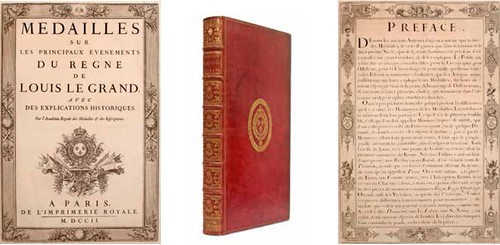
NB001 [Académie Royale des Médailles et des Inscriptions] Médailles sur Les Principaux Evènements Du Règne de Louis le Grand, Avec Des Explications Historiques. Paris, de L’Imprimerie Royale, 1702. Folio (430x285mm), beautifully engraved allegorical frontispiece by Charles Simonneau L’aîné after Antoine Coypel featuring the Royal portrait of the King by H. Rigaud in the upper left corner, title printed within engraved border with engraved vignette by Sebastien le Clerc below, 14 page preface signed by Anisson supplied in manuscript within engraved borders, 286 pages of plates printed on verso’s only, each depicting the obverse and reverse of 286 medals with descriptive text by Nicholas Boileau-Despréaux (1636-1711) and many with decorative culs-delampe below, all within elaborately engraved borders, ‘Table des Médailles Contenues en ce Volume’ on pages 287- 289, ‘Fautes d’impression’ on the recto of page 289. Sumptuously bound in the original full crimson French morocco with the Royal arms gilt embossed on both sides, three line border in gilt. Six raised bands, lettered in gilt, with the Kings crowned Royal cipher centrally placed in each compartment amidst further gilt decoration. All edges and inner dentelles gilt, marbled endpapers. From the library of the Earls of Macclesfield with their finely engraved armorial library plate on the first pastedown and embossed library stamp on prelims.
The book itself was first presented to Louis XIV on January 9th, 1702. It had been produced with little or no regard to time or expense - the finest engravers had been hired, the best quality paper was sourced and an entirely new and revolutionary font (Roman du Roi) was designed which was itself 7 years in the making and marked the first real change in Western font style since 1495. The purpose was to provide a carefully constructed history of Louis XIV’s reign through the commemorative medals which he himself had issued. The production of Médailles was not conceived of as a commercial project, it was an exercise in presentation and served as ‘an expression of academic respect for the typographic arts’ displaying not only the skill of the craftsmen involved but more importantly, Louis XIV’s role as patron of the arts. The finished product is a masterpiece of the bibliographic arts, sumptuously produced and perfectly fitting for ‘Le Roi Soleil’. Initially, it included the 14 page preface which was quickly suppressed from further copies, apparently upon the direct orders of the King himself who somewhat surprisingly, found the tone overly sycophantic. As such, copies with it present are exceptionally rare, particularly so in manuscript form as here.
Medallic Illustrations of Great Britain
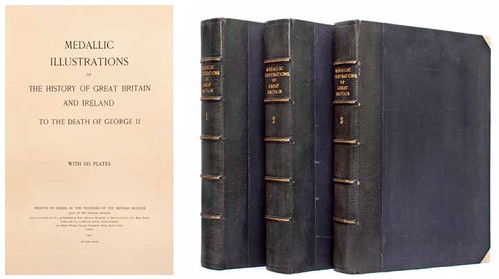
NB027 Hawkins, E., Franks, A. W. & Grueber, H. A. Medallic Illustrations of the History of Great Britain and Ireland to the Death of George II. London, 1885 & 1904-1911. Text in two volumes. Thick octavo, pp. engraved frontispiece, xxxii, (1), 724 + 866, line illustrations in the text; 183 superbly engraved plates each with descriptive text bound into three folio volumes, 64 page index. The plates, originally issued in 19 cloth backed folders, have here been expertly bound on linen hinges with all five volumes in matching black polished half morocco and cloth boards and all with neat vellum corners. Raised bands, gilt. Contents throughout virtually as issued. A monumental work based on the collection held at the British Museum. Still the standard reference and essential for any collector of commemorative medals. Rarely seen in such fine condition.
Van Mieris and Van Loon on Dutch Medals

PRESENTATION COPIES OF VAN MIERIS AND VAN LOON’S MASTER WORKS ON DUTCH MEDALS IN MAGNIFICENT CONTEMPORARY BINDINGS
All volumes with the engraved armorial ex-libris of the renowned Van Kinschott family on the front pastedown. A magnificent set of books both in terms of size and content, the pair forming what is still the standard reference to Dutch medals almost 300 years after their publication. Medals issued up until 1555 are covered by Van Mieris and those from 1556 to 1716 by Van Loon. Both titles are scarce but the exceptionally large format of both of these works suggests that they are one of a very small number of presentation copies perhaps given to the family directly. Two classic works, still essential for anyone studying the medals of the Low Countries. Exceptionally rare in this format, in magnificent contemporary bindings and with an illustrious provenance.
- All Six Volumes from R. C. Bell’s series on the token coinage of the eighteenth century
- An original interleaved copy of Dalton & Hamer
- The 1990 special leatherbound edition of Dalton & Hamer
- A complete original set of Forrer's monumental work on medallists
-Editor
To read the complete fixed price list, see:
http://www.baldwin.co.uk/fixedpricelistw201314/
The numismatic literature can be reached directly here:
www.baldwin.co.uk/media/cms/fixedpricelist/W201415
/Baldwins%20FPL%202014%20W%20-%205%20BOOKS.pdf
STOCKLEY OFFERS DISCOUNT ON BUSINESS AND BANKING BOOKS
Richard writes:
I am clearing out virtually all my business/banking books at a one low discount price of $5 each + post. Prices will remain in effect until the end of March at which time any remaining books will be disposed of. There will also be some numismatic titles at the end, all at $5 each. Price for the numismatic items remain in effect until the end of Feb. only. Most items are one of a kind so act quickly.
Specialist in Numismatic & Philatelic Literature
Richard Stockley
8620 ave. des Rapides,
LaSalle, QC
Canada H8P 2W2
514-564-0733
www.abebooks.com/bookseller/stockleysbooks
Always looking to buy good material.
BOOK REVIEW: SEA OF DARKNESS
 SEA OF
DARKNESS. By Brian Hicks. Spry Publishing. 512 pages. $26.95.
SEA OF
DARKNESS. By Brian Hicks. Spry Publishing. 512 pages. $26.95.
Brian Hicks has written the “Tale of Two Tales.” There are, indeed, two complete and absorbing stories here. The first, of course, is the fascinating story of the H.L. Hunley, the peripatetic little submarine that sank a Yankee warship during the siege of Charleston 150 years ago. Unfortunately the sub never returned, which leads to the second story.
It’s the treasure hunter’s story, “The Raising of the Hunley.” Never was an author better positioned or better prepared to write such an engaging and entertaining history. Hicks is an accomplished writer by trade, a Southern history buff by avocation and a close friend of many of the key movers and shakers who found, raised and are now restoring the submarine.
The Hunley was built in Alabama and transported by rail to Charleston by mechanical engineers with the motivations of privateers. Few boats have been sunk three times then raised and repaired twice before returning to combat.
Located in 1995 and recovered in 2000, the story of the Hunley’s retrieval is nearly as intriguing as the story of its 1864 sinking of the Housatonic. It is well known that the best-selling author Clive Cussler is also a dedicated marine historian and treasure hunter. He began actively searching for the Hunley in 1980. This story, too, is populated with strong, motivated people.
The flashback has long been an author’s favorite technique when telling a story that has key related events happening in different eras. Hicks employs a variation of the use of flashbacks. He writes the two stories in alternating chapters, and it is not at all disruptive to the reader. The two stories are so cleverly interlaced that the shuffling back and forth a century and a half ties the two narratives into one cohesive whole.
No anecdote ties the past and the present together better than the $20 gold piece in the skipper’s pocket. George Dixon had been wounded at Shiloh when a mini-ball was stopped by the gold coin. He had it engraved and carried for the rest of his life as his lucky piece. When the coin was recovered by the lead archeologist, Maria Jacobsen, on May 23, 2001, the circle was closed in a most emotional moment.
To read the complete article, see:
Review: ‘Sea of Darkness’ tells
two tales of the H.L. Hunley (www.postandcourier.com/article/20150125/PC1201/150129679/1003/book-tells-two-tales-of-the-hl-hunley)
THE BOOK BAZARRE
NUMISMATIST ISSUES SOUGHT FOR DIGITIZATION
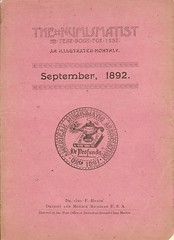 Barbara Gregory, editor of THE NUMISMATIST, is asking bibliophiles to help provide specific volumes and individual copies of The
Numismatist for the American Numismatic Association's 127-volume digitization project currently underway.
Barbara Gregory, editor of THE NUMISMATIST, is asking bibliophiles to help provide specific volumes and individual copies of The
Numismatist for the American Numismatic Association's 127-volume digitization project currently underway.
Following is a list of the issues/volumes the ANA needs. (Partial volumes will be accepted.)
1894
1896
1897
1898 (September issue only needed)
1900
1901 (May issue only needed)
1902
1903 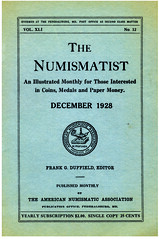
1904
1905
1906
1907
1916
1917
1918
1919
1920
1921
1923
1926
1927
 The ANA's Dwight N. Manley Numismatic Library has examples of these early editions, but most are bound and/or reside in its Rare Book Room.
The ANA's Dwight N. Manley Numismatic Library has examples of these early editions, but most are bound and/or reside in its Rare Book Room.
Gregory is requesting a loan of these volumes/issues only. "If possible, we would like to remove the staples from the (predominantly) saddle-stitched binding and reassemble them once the scans are complete. This procedure will be carried out by our magazine printer's experienced staff," she explains.
"We realize that surrendering these valuable issues is a difficult decision, but the end product will benefit the entire numismatic community," says Gregory. The digital archives will be completed later this year.
E-Sylum readers who can help are invited to contact Editor Barbara Gregory, 818 N. Cascade Ave., Colorado Springs, CO 80903-3279, phone 719-482-9831, e-mail gregory@money.org .
This is a marvelous and long-overdue project, and a nice companion to the recent news of a similar project at the American Numismatic Society to digitize the American Journal of Numismatics. This digital archive from the ANA itself, together with the ANS and Newman Numismatic Portal archives will create a great resource for collectors and researchers. So, who can help? -Editor
To read the earlier E-Sylum articles, see:
ELECTRONIC NUMISMATIST PUBLISHED (www.coinbooks.org/esylum_v07n50a04.html)
ANS NAMES PUBLICATIONS DIRECTOR, PLANS DIGITIZATION
(www.coinbooks.org/esylum_v18n03a08.html)
FOOD STAMP CHANGE TOKEN INFORMATION SOUGHT
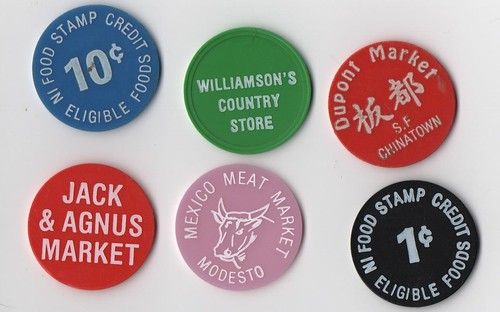
With the guidance of Paul Cunningham I have been gifted the immense notes and collection he has put together of Food Stamp Change Tokens. With the assistance of long time collectors Eliseo Ramos and Jerry Schimmel I have pieced together a sizable collection and about a year and a half ago began work on a catalog of these items.
I have been listing each token available for each state and town. Obviously, there are thousands of listings. I have also produced a bit of a Collector's guide including such topics as the manufacturers, the politics of the food stamp era, personal stories of recipients, the original authors and researchers of these and even grading plastic tokens such as these. I am not including the paper scrip as there is even far more of that, much of it lost to time.
What I'm really hoping for are some more contributions from some of the collectors who I may have missed who have been enthusiastic about this topic from the beginning or those who have any examples in their collections who would like to share listings and photos that I may not have. This will also help in producing a more accurate rarity scale. I'm looking for more information on the manufacturers and any collecting or historical price points. My hope is to have the final ready this time next year for publication. Any contributors will be acknowledged in print.

STANDING LIBERTY QUARTERS AUTHOR CLINE DIES
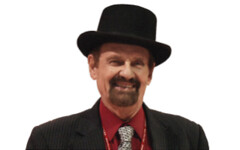 J.H. Cline, of Palm
Harbor, Fla., died Jan. 8, 2015, from injuries suffered in an accident.
J.H. Cline, of Palm
Harbor, Fla., died Jan. 8, 2015, from injuries suffered in an accident.
He was owner of J.H. Cline Rare Coins. Mr. Cline specialized in Standing Liberty quarter dollars for more than 40 years.
Mr. Cline began his full-time career in numismatics in 1964. He spent 31 years operating his own coin shop, Cline’s Rare Coins on Salem Avenue in Dayton, Ohio, before moving to Palm Harbor.
Mr. Cline was a life member of the American Numismatic Association. He was also a member of the Indiana State Numismatic Association, National Silver Dollar Roundtable, Florida United Numismatists, Central States Numismatic Society, and other coin clubs.
In 1975 he published Standing Liberty Quarters. The fourth edition of the book was published in 2007.
To read the complete article, see:
J.H. Cline, longtime dealer and researcher of Standing Liberty
quarter dollars, dies Jan. 8 (www.coinworld.com/insights/Longtime-coin-dealer-J-H-Cline-dies.html)
SUSAN GAMBLE, 1957-2015
 Susan G. Gamble,
who created the artwork displayed on numerous U.S. coins, died Jan. 14 after an accident. She was 57.
Susan G. Gamble,
who created the artwork displayed on numerous U.S. coins, died Jan. 14 after an accident. She was 57.
As a master designer for the United States Mint, Gamble’s artwork is stamped on the reverse side of pennies, nickles, gold and silver dollars and commemorative coins, among others.
Raised in Virginia, Gamble became interested in art in junior high school. Her mother died when she was 16, leaving her and her twin sister to take over many of the household duties.
After graduating early from high school — as class valedictorian — Gamble went on to attend Virginia Commonwealth University, earning a degree in fine arts in 1978.
“It’s hard to make a living at painting,” her husband Michael Gamble said. “After we got married, right after she graduated, she started branching out into graphic design.”
Purchasing a Macintosh computer in the mid- 1980s, Gamble taught herself the desktop publishing program PageMaker, improving her skills as she and her husband, an Air Force officer, moved frequently throughout the U.S.
“She just expanded her portfolio over the years … began doing layout and design for various small magazines,” her husband said. “As it became easier to do things by computer, she was able to maintain clients.”
From Albuquerque, New Mexico to Northern California, Gamble worked from home and raised the couple’s two children. She especially enjoyed living in the Washington, D.C. area where she worked as a graphic artist for the National League of Cities, and her proximity to the area’s many museums.
It was while living in Oklahoma in 2004 that Gamble was chosen from among 306 artists for the Mint’s Artistic Infusion Program, submitting designs for commemorative nickels.
She received the program’s “Excellence in Design” award in 2008.
Gamble also won the international Coin of the Year Award for Historical Significance for the United States of America for her 2007 Jamestown silver dollar design, one of her husband’s favorites.
Another high point of her career, one that had a personal connection, was designing the Air Force Combat Action Medal, which was introduced in 2007. It was an assignment she considered a “gift of love.”
The couple decided to live in South Texas after her husband’s retirement, even though they had planned on returning to Virginia.
Gamble had fallen in love with San Antonio during their two assignments in the city.
To read the complete article, see:
Gamble designed coin artwork for
the U.S. Mint (www.mysanantonio.com/obituaries/article/Gamble-designed-coin-artwork-for-the-U-S-Mint-6031079.php)
 Former Chief Engraver John Mercanti recalled Gamble’s work, telling CoinWeek,
“I remember working with her, when she started with us. It took a while for her designs to click, but I told her to stick with it… that one day her
designs would be selected. Once it clicked for her, she soared.”
Former Chief Engraver John Mercanti recalled Gamble’s work, telling CoinWeek,
“I remember working with her, when she started with us. It took a while for her designs to click, but I told her to stick with it… that one day her
designs would be selected. Once it clicked for her, she soared.”
Mercanti, one of the most prolific coin designers in United States history, thinks fondly of many of Gamble’s designs–both used and unused–but it’s the reverse of the 2007 Jamestown 400th Anniversary silver dollar that stands out. It later won the International Coin of the Year Award for Historical Significance for the United States.
“That was my favorite design of hers,” Mercanti said.
Condolences from friends and former colleagues poured into a guest book hosted by legacy.com.
Fellow designer Richard Masters wrote, “I always admired both her degree of professionalism and her enduring dedication to her art.”
Designer Joel Iskowitz, who shared a number of coin sides with Gamble (including the 2009 commemorative dollar honoring Louis Braille) added, “Susan was an exceptional artist and a very fine person. Her designs were some of the best and cleanest of our group and she herself was a ray of sunshine.”
Of Gamble’s lengthy portfolio of selected designs, it was the 2008 Bald Eagle gold $5 obverse that Iskowitz liked most, giving it the highest praise.
“I always told her that I thought her Bald Eagle gold coin design was among the most beautiful in American coinage,” Iskowitz said.
To read the complete article, see:
In Memoriam: Susan Gamble, 1957-2015
(www.coinweek.com/coins/news/memoriam-susan-gamble-1957-2015/)
NOTES FROM E-SYLUM READERS: JANUARY 25, 2015
History of Central States Still Available
Ray Lockwood, Central States Numismatic Society Education Director writes:
I have a few of my History of Central States softback books left to sell. I will sell them at $6.00 and include postage. My email address for orders is sunrayofmarion@aol.com .
To read the earlier E-Sylum article, see:
NEW BOOK: HISTORY OF THE CENTRAL STATES NUMISMATIC SOCIETY
(www.coinbooks.org/esylum_v17n05a04.html)
1796 Cent S-96 Sold in Woolley & Wallis Sale
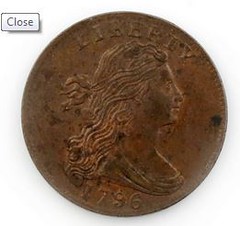
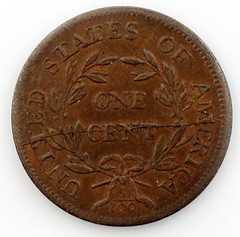
Mike Knight writes:
I thought the readership might be interested in the 1796 cent sold on Wednesday 21st by Salisbury, Wiltshire (United Kingdom) auctioneers Woolley & Wallis. It was estimated at £500-700 and graded VF (which I thought understated its condition), and was unidentified as to variety. Only the obverse was shown in their online catalogue. I asked for an image of the reverse, and whilst not an expert on US coins, it appeared to me to be the rare Sheldon 96, which would explain the price realised.
To read the complete lot description, see:
Silver, Coins and Medals - Lot 682
(www.woolleyandwallis.co.uk/Lot/?sale=SV210115&lot=682&id=285565)
The Frank Sinatra Congressional Gold Medal
Bill Gibbs of Coin World writes:
The U.S. Mint struck a single example of the Frank Sinatra congressional gold medal; bronze examples of the were never struck, owning to a legal issue involving the source material for the design.
As Coin World reported in its April 20, 2009, in an article about a presentation by former Mint engraver-sculptor Thomas D. Rogers Sr.: “Rogers had worked on it [the Sinatra medal] for six months, and it went into production with a design based on photos provided by Sinatra’s daughter, Nancy. Just as the medal was ready to be released, the photographer of the source photo contacted the legal department of the U.S. Mint and asked for $15,000 in payment. Ultimately, neither the Sinatra family nor the U.S. Mint paid the fee and a single 3-inch medal was presented to the Sinatra family. No bronze medals were made for sale to the public as is traditional for congressional gold medals.”
To read the earlier E-Sylum article, see:
THE TRUMAN CONGRESSIONAL GOLD MEDAL (www.coinbooks.org/esylum_v18n03a13.html)
More on the Macerated Currency Bust of George Washington
Steve Hayden writes:
I have information on the Macerated Currency bust of George Washington. I was a third partner in the transaction which occurred 5 to 10 years ago. Rich Rossa (semi retired at the time) found it on the bourse floor of a Baltimore coin show. He brought it to the table Steve Tanenbaum and I were sharing and the three of us decided to purchase it jointly. I believe Dave Bowers photographed the piece shortly after its purchase for a then upcoming book, likely on George Washington quarters. I don't remember if it made the book or not. I do remember, however, the troubles with shipment that Alan mentioned.
Steve had it tentatively sold to Bert Cohn and was greatly worried about shipping and insurance. Steve, a very skilled packer in his own right, ultimately decided to take it to a shipping/packaging company and letting them do the packaging, reasoning if the worst happened we would have the best chance at an insurance claim.
Nearly the worst happened and the bust arrived with George's face flattened. The company that did the packing promptly refused the insurance claim. Their reasoning... anything that broke after their careful and professional packaging must have been too fragile to ship in the first place. I remember Steve making additional claims, getting appraisals, repair estimates, theoretical appraisal of a potentially repaired item etc.. He meet with the type of stonewalling you fear from a government agency or large corporation.
At one point I suggested taking our lumps and accepting whatever Bert thought it was worth "as is" and letting him arrange for its repair. As far as I know this remained an open issue at the time of Steve's tragic death though the original transactions were years earlier. To the best of my knowledge the bust is still damaged and likely in the estate of Bert Cohn.
To read the earlier E-Sylum article, see:
MORE ON MACERATED CURRENCY (www.coinbooks.org/esylum_v18n03a12.html)
Joel Iskowitz Original Art Work Up For Auction
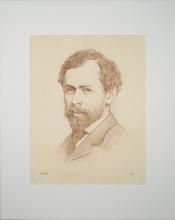 Dick Johnson writes:
Dick Johnson writes:
Two dozen original works of art by coin and medal artist Joel Iskowitz are going up for auction this week. The auction, conducted by Tangible Investments, contains portraits of celebrities, political figures, entertainers, and, of numismatic interest, a portrait of Victor David Brenner. The sale closes February 2nd.
To view the sale, see:
Joel Iskowitz Original Postage (Philatelic) And Coin
(Numismatic) Art Sale - February 1st(24 Lots) by Tangible Investments
(www.invaluable.com/catalog/searchLots.cfm?scp=c&catalogRef=SQIEA9I0YR)
Dealer in Current World Coins Sought
Nick Graver writes:
Is there a U. S. source for the two current “Photographic” coins shown in last week's E-Sylum issue?
- Bulgaria 10 leva 2015.
- Hungary 2000 forint, 2014 Rectangular.
Thanks for thoughts,
Nick
Nicholas M. Graver
nmgraver@gmail.com

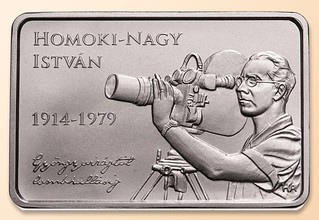
To read the earlier E-Sylum article, see:
SOME RECENT COIN DESIGNS: JANUARY 18, 2015 (www.coinbooks.org/esylum_v18n03a30.html)

19TH-CENTURY NUMISMATIST WARREN GEE
Born 185 years ago to Nicholas and Adaline (Daniels) Gee in Ohio, Warren Gee became nationally known in the mid-1880s for his enthusiastic love of coin collecting and the money he made trading in rare American coins.
But, when he died in 1905, the Spring Lake resident dropped out of the news, and what became of his coin collection is unknown. In today's value, Gee's coin collection would be worth a small fortune.
Gee's personal collection of coins was regarded as one of the best in the nation at the time.
“Warren Gee, of Spring Lake, Mich., is the possessor of one of the most complete and finest collections of money in the county,” the Brooklyn New York Union reported in the spring of 1885. “The collection of cents embraces specimens of every (U.S.) coinage from the first to the last, all in fine condition.”
It was reported that Gee possessed the first U.S. cent bearing the date of 1793. That first cent “had on the obverse a female head with flowing hair. The head faced the right, not the left.”
Warren Gee, a produce and grain broker by trade serving Ottawa County and locations in Wisconsin, was also once president of the Spring Lake Horticultural Society. His wealth afforded him the hobby of collecting, which turned into a side business buying and selling rare U.S. coins.
Also a stock broker, Gee conducted a partnership and office with George Knowles Jr. in Milwaukee, where he built a second home in 1897.
Gee was one of the original subscribers to Illustrated Encyclopedia of Gold and Silver Coins of the World magazine, an early publication for collectors of coin and paper money. He made national headlines in an article published in the Weekly Wisconsin on Jan. 7, 1885. Within years, he gained respectable recognition for his hobby-turned-business.
“American coinage from Warren Gee, of this city, is well-known throughout the country as a collector,” the Weekly Wisconsin reported on May 5, 1888.
Newspapers and periodicals began publishing Gee's expertise regarding coins. The collector-turned-dealer was called “the famous coin collector of Spring Lake, Michigan” in several publications.
“Last year, I sold a brilliant proof quarter of a re-strike of 1827 to a New York gentleman for $135,” Gee told the Chicago Inter-Ocean newspaper in an article published in early 1887. “Not long ago, the identical coin sold at public auction for $210.”
“A cent of 1799, in good condition, which I sold to a New York dealer for $50, was sold for $75 not long after,” Gee added.
In an 1885 widely published article, Gee told a reporter he witnessed a rare cent sold at a New York auction.
“I saw an unusually fine 1804 cent sold in New York a month ago for $200,” he said. “It was an uncirculated cent, which had been kept in a box of cotton, and was perfectly bright. There was a competition at the sale.”
The coin, plain 4 with stems, uncirculated, has an estimated value of $15,000 today.
It was reported that Warren Gee possessed “every (U.S.) coinage from the first to the last,” which would have been to the year he died in 1905. But the old saying, “you can't take it with you,” is true.
Thus, whatever became of Gee's coin collection? Does it still exist with an ancestor today, or was it sold off long ago? Perhaps ancestors of Gee will chime in regarding this column, and we'll have an answer in the near future.
Joel Orosz writes:
Grand Haven is a lovely little lake Michigan resort town, about 90 miles from Kalamazoo. It doesn't surprise me that the reporter doesn't know anything about numismatics, and also obviously doesn't understand the distinction between and ancestor and a descendant.
I've never heard of Warren Gee before, but he must have had a respectable collection if someone living in the wilds of lower Michigan was noticed by a reporter in Brooklyn in 1885. I imagine his sudden death left behind a family who didn't know how to wisely dispose of his coins, and it probably went for a song to some dealer in Indianapolis.
Here is my question--was Warren related to E. Gordon Gee, formerly President of The Ohio State University, and now President of West Virginia University?
Wonderfully intriguing, isn't it? A significant collection formed by a part-time coin dealer a century ago, and it seems to have vanished without trace.
To read the complete article, see:
Finding Gee's coin collection makes a lot of cents
(www.grandhaventribune.com/article/strange-grand-haven/1593991)
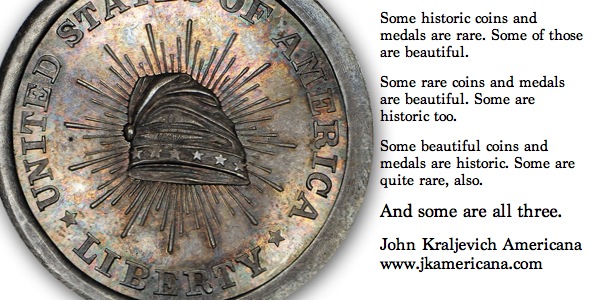
WANTED: A MEDALLIC VISUAL DICTIONARY
Cataloging coins is fairly easy. Cataloging medals is somewhat difficult. What's the difference? It is in the description of the devices.
Usually, but not always, coin devices are rather obvious. Coin designers purposely choose images that are well known. When the coin circulates it is beneficial that the public instantly recognize the coin from its image. They can easily recognize the coin from its size, color, but its image is also important.
Not so with medals. Since they are not intended to circulate, medal designers are not bound by these restrictions. Their imagination can run wild to incorporate devices that often are not well known, if not outright obscure. Not only is that part of their charm, it is opportunity for topic collectors to obtain a medal that pictures an object of a particular topic.
You won't find, say, a pickup truck or a widget on a coin but you could on a medal. It could be the product the issuer wants to honor. They manufacture pickup trucks or widgets so it must appear on a medal.
That brings us to the problem of medal catalogers to be able recognize all the possible devices which appear on medals. Also a seasoned cataloger is required not only to mention it is a pickup truck or a widget, but to be able to record what kind, perhaps the period it was made and related data.
I have said before, you must bring a wide experience in life to be a good cataloger.
Now what kind of specialized knowledge should a medal cataloger have at his command? - knowledge of symbols, heraldic images and their meaning, knowledge of costumes, what a person portrayed is wearing, types of headgear, types of male facial hair, ability to recognize any possible device, even the ability to identify animals and to determine if they are generic, or of a specific breed, as for dogs.
It is not satisfactory to say a medal shows a dog, but it is a Yorkshire terrier or a golden retriever. Likewise for horses: is it an Arabian or a mustang, or a whatever?
That brings me to mention the need for a handbook for catalogers. A book which would identify the most common images on medals revealing the specific kind. Such a book is called a Visual Dictionary.
I have had the Macmillan Visual Dictionary in my library virtually since it was first published in 1992. I see now Webster has brought its Visual Dictionary to the internet. Still, both of these do not fill the bill for the medal cataloger.
I searched Abebooks for Visual Dictionary and got 9,400 hits. These were mostly for foreign language learning. Also unsatisfactory.
So it must be left to us. If we want such a book we must compile it within the numismatic field. What about it, E-Sylum readers? Anyone up to the task?
2015 HIGH RELIEF GOLD COIN DESIGN CANDIDATES
The United States Mint has released the design candidates for this year’s upcoming 2015 High Relief Gold Coin and Silver Medal. Today and next week, these designs will be reviewed by the Commission of Fine Arts (CFA) and Citizens Coinage Advisory Committee (CCAC) in separately held meetings.
Last year, the CCAC had given their enthusiastic support for high relief gold coins and silver medals to be produced by the United States Mint. The new program was viewed as a historic initiative that could potentially fulfill former US Mint Director Edmund Moy’s calls for a neo-Renaissance in American coin design.
The obverse design for the coin and medal would contain a modern rendition of Liberty, while the reverse would carry a depiction of an eagle. The gold coins would be produced under the authority granted to the Secretary of the Treasury under 31 U.S.C. § 5112(i)(4)(C) to mint and issue gold bullion or proof coins with broad discretion over coin specifications, designs, quantities, denominations, and inscriptions. The authority for the silver medals would come under 31 U.S.C. § 5111(a)(2) which provides the Secretary with broad authority to strike national medals and other medals.
Some Obverses
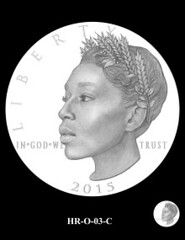
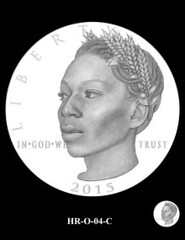
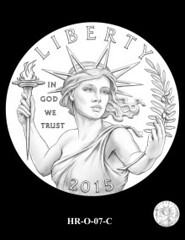


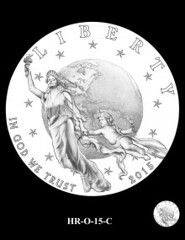
Some Reverses
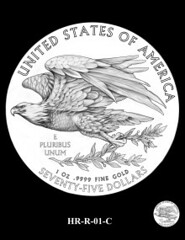

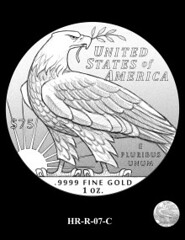
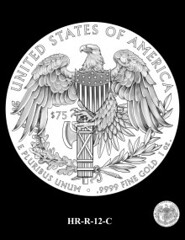

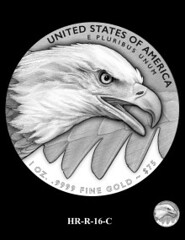
To read the complete article, see:
2015 High Relief Gold Coin and Silver Medal
Design Candidates (http://mintnewsblog.com/2015/01/2015-high-relief-gold-coin-and-silver-medal-design-candidates/)
The Commission of Fine Arts recommended proposed designs for the 2015 High Relief gold $75 coin and companion silver medal at its Jan. 22 meeting. Two obverse designs and two reverse designs were recommended.
Of the two obverses the CFA recommended, one depicts a wreathed bust of Liberty, with the date 2015 and inscriptions LIBERTY and IN GOD WE TRUST. The second obverse depicts Liberty standing, crowned with leaves, holding an American flag on staff in her left hand and a torch in her right.
Of the two reverses that received CFA recommendation, one features an eagle in flight, clutching olive branches, with inscriptions UNITED STATES OF AMERICA and E PLURIBUS UNUM. The denomination is presented as SEVENTY-FIVE DOLLARS and the weight and fineness as 1 OZ. .9999 FINE GOLD.
The second reverse recommended depicts an eagle perched on a branch ruffling its wings that extend off the edge of the coin design. UNITED STATES OF AMERICA and E PLURIBUS UNUM are inscribed around. The weight in gold and fineness appear in two lines in the field in front of the eagle as 1 OZ. .9999 / FINE GOLD. The denomination appears as $75.
The coin designs recommended by the CFA were selected from among 41 proposed obverse and reverse designs. The CFA also reviewed 41 obverse and reverse designs for the silver medal that are the same as those for the gold coin, but without the coin inscriptions (mandated mottoes, date, denomination, weight and fineness).
The same designs are to be reviewed during a two-day session Jan. 27 and 28 in Washington, D.C., by the Citizens Coinage Advisory Committee for their recommendations. The recommendations from both panels along with those of the Mint will be forwarded to the Treasury Secretary for final approval.
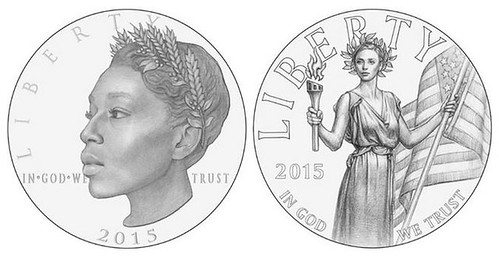
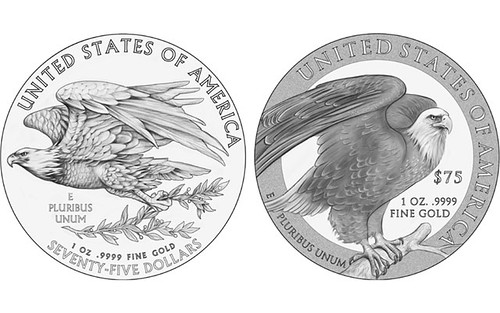
To read the complete article, see:
Commission of Fine Arts recommends
designs for 2015 High Relief gold coin (www.coinworld.com/news/2015-75-dollar-gold-coin-to-be-high-relief-not-ultra-high-relief.html)

INDIAN PEACE MEDALS IN STACK'S BOWERS 2015 AMERICANA SALE
Indian Peace medals are a true tangible link to the history and politics surrounding the relations between the Native American tribes and the governing bodies who made treaties with those tribes. The tradition of awarding medals to important Native Americans began in colonial times, and continued through to 1890. Most collectors are familiar with the silver and bronze medals issued by United States presidents from Washington through Hayes, as these appear on the market with some frequency. Over the years, Stack’s Bowers Galleries has offered major collections, including The John J. Ford, Jr. Collection, The Lucien LaRiviere Collection, and others.
Less known, but equally important from a historic and rarity perspective are the medals issued by Great Britain, France, and Spain to Native Americans. Again, Stack’s Bowers is proud to be at the forefront of offering significant holdings of these medals as well, auctioning both The John J. Ford, Jr. Collection and The John W. Adams Collection within the last decade. These two collections brought these obscure medals into the light.
In the 2015 Americana Sale, we have been consigned four pieces from various consignors that represent different types of these important medals.

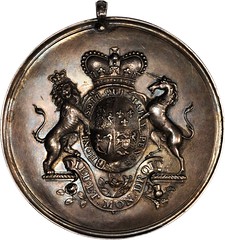
Lot 17 is a superb example of the George III large size solid silver medal, and is from the period of 1776-1812. Let those dates hit you for a moment. The relationship of Britain and the native tribes cause much consternation for the infant United States. Indian raids on American settlements were sometimes provoked by British agents, just outside the border in what was still British occupied territory.

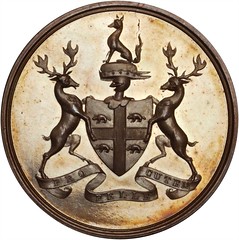
Lot 18 is a copper bronzed example of the circa 1820 George III Hudson’s Bay Company medal. This interesting medal is represented in our sale by a lovely Mint State example.
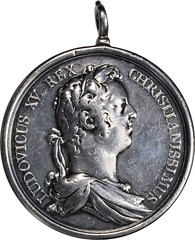

Lot 19 is a very rare silver Honos et Virtus medal, circa 1737. This was the last Indian Peace medal type that was issued by the French for their North American land holdings. This piece was worn proudly by the recipient and perhaps later generations of his family, as it is worn to a “Choice Fine” designation. Based on data published by numismatic scholar John W. Adams, and expanded by John Kraljevich, it would appear that perhaps a dozen of these medals are currently accounted for, with nine impounded in museums. This is a newly discovered example and will create quite the stir when it is sold.


Lot 20 is another newly discovered rarity in the field. We are pleased to offer a Spanish Al Merito Y Fidelidad Medal in silver, only the second example known (the other is permanently impounded at the American Numismatic Society). As such it was missing from every important collection of Indian Peace medals offered in the past. For specialists, this is not an opportunity to be missed.
These historically interesting and important numismatic rarities are part of a great selection of medals and tokens being offered in the 2015 Americana Sale
To read the complete article, see:
Colonial History Linked with Four Indian Peace Medals Being Offered in Our February New York Americana Sale.
(www.stacksbowers.com/NewsMedia/Blogs/TabId/780/ArtMID/
2678/ArticleID/64946/Colonial-History-Linked-with-Four-Indian-Peace-Medals
-being-offered-in-the-February-Americana-Sale.aspx)
BAKELITE "MOHAWK" ENCASED LIBERTY NICKEL
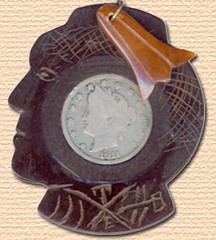

When I first encountered this installment's Exonumia Corner item, the words that immediately popped to mind were "Drums Along The Mohawk," a classic 1939 black and white movie starring Henry Fonda and Claudette Colbert, based on the novel of the same name by Walter D. Edmonds. The movie was a childhood favorite of mine in the 1950s, and nearly every time it came on television— depending, of course, on whether the weather was good enough to play outside—I would sit cross-legged on the living room floor and watch the adventure unfold. Indians attacking Mohawk Valley settlers, the local fort under heavy siege and in dire straits, and the hero to the rescue... those were the days.
The Bakelite "Mohawk" featured this week is about 2" high and 1¾" wide. It is made of dark brown Bakelite, a plastic-like material that was popular in the 1930s and 1940s. Appliance plugs, light switch plates, and numerous other items were made of Bakelite before the plastics revolution began. My Native American friend has a 1911 Liberty nickel at its center, and judging by the wear on both the coin and the host, my guess is the Bakelite Mohawk and the coin are contemporary to 1911. There is also a Bakelite amber tassel that hangs from the top of the Mohawk. The obverse of the Bakelite Indian has an eye and hairlines scratched in, and below the coin is a fanciful engraving that shows crossed spears with a "T" in the upper section, and an "E" in the lower section. There is a tiny tomahawk to the right of the crossed spears, and three feathers hang down on the leftmost spear. The 1911 Liberty nickel is Good to VG overall, and as noted, if I had to grade the Mohawk host, I'd give it a similar grade. I have no idea what this unusual piece was originally for—a club such as Woodmen of the World or some other origin? All I know for certain is that it's an enjoyable part of my exonumia. I've never seen another!
To read the complete article, see:
“Drums
Along The Mohawk” (www.stacksbowers.com/NewsMedia/Blogs/TabId/780/ArtMID/
2678/ArticleID/64943/%E2%80%9CDrums-Along-The-Mohawk%E2%80%9D.aspx)
CONTEMPORARY COUNTERFEIT COINS
1787 Contemporary Counterfeit 2 Reales
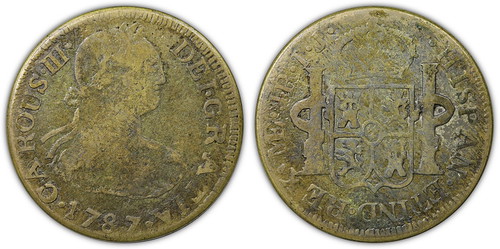
1787 Contemporary Counterfeit 2 Reales. Very Fine [uncertified]. Kleeberg 87A-L4. Struck in brass, with some of the original silvering still adhering. A very rare issue; Kleeberg knew of three specimens, one of which is impounded in the ANS museum in New York. $495.
1852 Contemporary Counterfeit Quarter Eagle

1852 Contemporary Counterfeit Quarter Eagle. Extremely Fine [uncertified]. Struck in brass, and with none of the gold wash remaining. Quite crude, with dies cut by an engraver with very little talent for this line of work. $195.
1854 Contemporary Counterfeit Gold Dollar
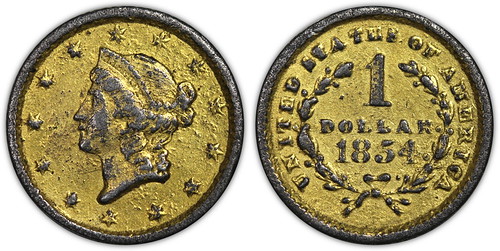
1854 Contemporary Counterfeit Gold Dollar. Very Fine [uncertified]. Another type 1 gold dollar with most of the gilt intact. $75.
'1925' Contemporary Counterfeit Indian Half Eagle
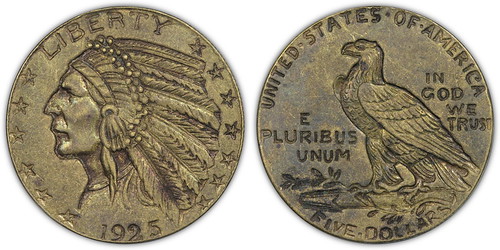
'1925' Contemporary Counterfeit Indian Half Eagle. Extremely Fine [uncertified]. Contemporary Counterfeit gold coins of this design are rarely encountered, in my experience. This coin came from my personal type set. I'm guessing these counterfeiters were not very successful, as there were no genuine $5 gold coins dated 1925. Hopefully they did not quit their day jobs. $250.
To visit Dave's web site, see:
www.davewcoins.com
THE BOOK BAZARRE
A 3D-PRINTED COUNTERFEIT DETECTOR
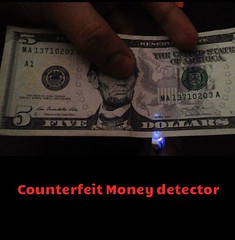 For those of you who are still paying with cash or, more importantly, taking
cash payments, an Instructables contributor, Carmelito Andrade, shared instructions and STL files for 3D printing your own portable counterfeit money
detector. Andrade, from Stamford, Connecticut — an electronics tinkerer, 3D designer and printer, and also a farmer — created this device, which is
smaller than the size of the bill you’re checking. It fits into your wallet and, because it’s battery operated, needs only to be switched on to run a
quick scan on a bill.
For those of you who are still paying with cash or, more importantly, taking
cash payments, an Instructables contributor, Carmelito Andrade, shared instructions and STL files for 3D printing your own portable counterfeit money
detector. Andrade, from Stamford, Connecticut — an electronics tinkerer, 3D designer and printer, and also a farmer — created this device, which is
smaller than the size of the bill you’re checking. It fits into your wallet and, because it’s battery operated, needs only to be switched on to run a
quick scan on a bill.
Andrade’s device, which also functions as a small flashlight, works on the same principle as any other ultra violet (UV) light-based detector: When you illuminate the bill with a UV light source, a thin, vertical strip to the left of the President’s head will appear. The strip is printed on the bill in fluorescent ink that is not visible to the naked eye. The strip is a specific color based on the denomination of the bill. $100s are red, $50s are yellow, $20s are green, $10s are orange, $5s are blue.
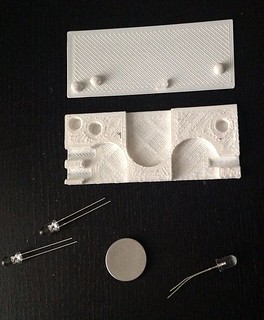 For this project, you will need a few electronics components in addition to the 3D printed parts. You should be able to purchase the electronic parts
at any hardware store:
For this project, you will need a few electronics components in addition to the 3D printed parts. You should be able to purchase the electronic parts
at any hardware store:
- Two UV LEDs
- One white LED
- A coin cell battery (CR2302)
- Super glue
Andrade’s STL files are available via the Instructables page. It took him about an hour to print all of the non-electronic parts, which is easily assembled using his instructions and some super glue.
To read the complete article, see:
3D Print Your Own Portable Counterfeit Currency Detector
(http://3dprint.com/36541/3d-print-counterfeit-detector/)
SELECTIONS FROM THE GOLDBERG JANUARY 2015 SALE
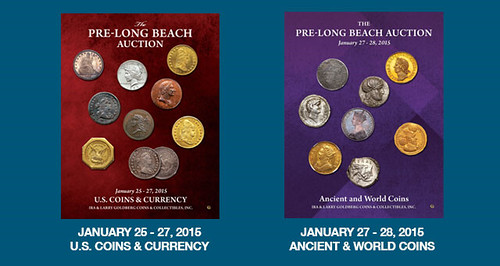
Lot 53: 1792 Washington "Roman Head" Cent
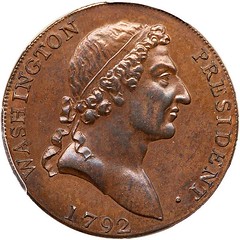
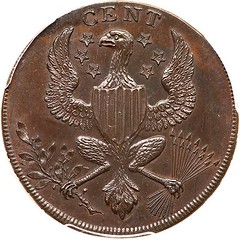
1792 Washington "Roman Head" Cent Breen-1249, Baker-19. PCGS graded Proof 64 Brown.
The obverse is beautiful glossy golden tan and light brown with darker steel brown toning on the highpoints while the reverse is a darker shade of steel brown and chocolate with lighter brown in protected areas. Traces of lighter golden tan faded down from mint color can be found in some of the protected areas on both sides. The fields are smooth and slightly reflective and this cent offers excellent eye appeal. No spots or contact marks. An area of darker toning along the rim left of the C in CENT can help identify this piece. The edge is lettered "UNITED STATES OF AMERICA."
The "Roman Head" Cents depict Washington in the style of a Roman Emperor, an image that most certainly was contrary to Washington's desires. These were struck in England during the "Conder Token" era and they are among the rarest and most desirable of the Washington coppers. About 15 examples known today (and several of those are worn or otherwise impaired). A superb example of this very rare Washington copper. Listed on page 83 in the "Redbook." Weight 197.5 grains. Pop 3; 3 finer, 2 in 65, 1 in 66. Estimated Value $65,000-UP.
From the Ted L. Craige collection, Stack's Bowers Galleries 1/22/2013:11499.
To read the complete lot description, see:
Lot 53 of 4680: 1792 Washington "Roman Head" Cent Breen-1249,
Baker-19 PCGS graded Proof-64 Brown (www.goldbergcoins.com/view-auctions/catalog/id/40/lot/88807/)
Lot 79: 1793 Half Cent C-2


1793 C-2 R3. PCGS graded MS-63 Brown
The reverse of this half cent was plated in the Ebenezer Gilbert's 1916 reference "The United States Half Cents" (Plate 1, the 1793 "1-3" reverse), and both sides were plated in the 1914 ANS Exhibition of United States and Colonial Coins Catalog (Plate 23, the Crosby 2-A provided by Hillyer Ryder). In addition this is the plate coin for the die variety (the large photos) and for the late die state (the smaller State II photos) in "Walter Breen's Encyclopedia of United States Half Cents 1793-1857." The attribution and Missouri Cabinet provenance are shown on the PCGS label. PCGS population 1; the finest of only 2 graded Mint State for the variety. PCGS #35006.
(Note: This half cent has been part of the fabulous Missouri Cabinet since the purchase of the Showers Collection in 1976 but it was misplaced in 1997 and was not included in our sale of that collection in January 2014. The coin was subsequently "rediscovered" after the auction. This offering completes the Missouri Cabinet sale, and we are making copies of this page available for insertion into the January 2014 catalog so that important reference can represent the complete Missouri Cabinet Collection.). Estimated Value $80,000-UP.
Ex George H. Earle, Jr., Henry Chapman 6/25/1912:3599-Hillyer Cooper Ryder 2/11/1928-Ryder Estate 5/5/1945-Wayte Raymond 12/1944-New Netherlands Coin Co., 6/23/1954:259-Philip M. Showers, Stack's (privately) 1969-Willis Harrington duPont-Fred S. Werner 2/1976-Superior Stamp & Coin Company, Inc., 2/1976-Joe Flynn & Son Rare Coins, Inc. (Joseph S. Flynn, Jr.) 4/20/1976 (privately)-R. Tettenhorst-Eric P. Newman Numismatic Education Society (EPNNES)-Missouri Cabinet (Mocab 93.2.2).
To read the complete lot description, see:
Lot 79 of 4680: 1793 C-2 R3 PCGS graded MS63 Brown
(www.goldbergcoins.com/view-auctions/catalog/id/40/lot/88833/)
Lot 187: 1831 Proof Half Cent
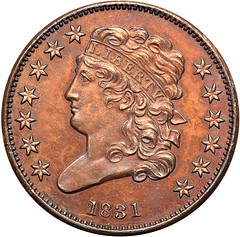
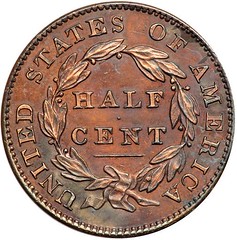
1831 Proof Original Breen 1-A R7- (as a proof). PCGS graded Proof 62 Red & Brown. Reddish tan and brown fading to darker bluish steel in protected areas. Ample faded red shows on both sides, probably from a very old cleaning. The fields are nicely reflective but they do show myriad fine hairlines. Very sharply struck. The best identifying marks are a scuff on the leaf tip left of the H in HALF and a tiny boomerang-shaped struck-through line above IC in AMERICA (as struck). The "Accessory E" in the wreath under the E in STATES is bold.
Less than a dozen proof strikes are known of these originals plus about 20 circulated pieces that are commonly thought to be business strikes (but that is debatable as some feel all were proof strikes). Our grade is Proof-60. The PCGS label indicates this is a Proof Original strike and mentions the Carvin Goodridge provenance. PCGS population 1; the only example graded at PCGS in Red & Brown (#1187). Estimated Value $50,000-UP. Ex Auction '89 (Stack's) 7/8/1989:1509-Carvin Goodridge Collection.
To read the complete lot description, see:
Lot 187 of 4680: 1831 Proof Original Breen 1-A R7- (as a proof) PCGS
graded PR62 Red & Brown (www.goldbergcoins.com/view-auctions/catalog/id/40/lot/54655/)
Lot 1070: 1872 Two Cents
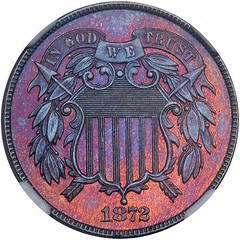
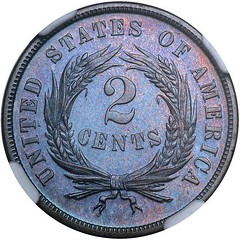
1872. NGC graded Proof 66 Red & Brown. In a somewhat variegated fashion, blue-purple and deep cherry-red colors are seen over the obverse of this remarkably toned Gem; similar blue-purple dominates the reverse. The design elements are fully struck up and reveal pleasing variance with the reflective obverse fields. No mentionable contact marks or spots are evident on the carefully preserved surfaces. Only 950 pieces were minted. Pop 38; 6 finer, 1 in 66 Star, 4 in 67, 1 in 67 Star . Estimated Value $1,000 - 1,200.
The Agora Collection.
To read the complete lot description, see:
Lot 1070 of 4680: 1872 Two Cents. NGC PF66
(www.goldbergcoins.com/view-auctions/catalog/id/40/lot/83498/)
Lot 1260: 1796 Draped Bust Quarter Dollar
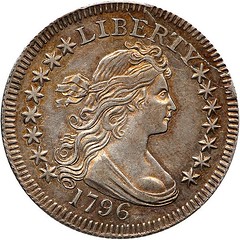
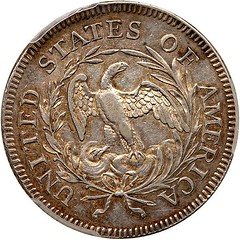
1796 Browning-2, Rarity 3. PCGS graded AU-55 PQ. CAC Approved. Lovely mottled golden-russet and lilac highlights dance together on the surfaces of this partially lustrous specimen. Liberty's curls are fully defined and show just touches of light wear, while the eagle's wing feathers on the reverse are complete. Even a few details from the eagle's eye are visible. Close inspection with a loupe reveals only the most minor surface defects, none of which detract from the substantial eye appeal. As America's first quarter and the only year for which the Small Eagle reverse is seen on this denomination, this is a popular type coin in all grades, especially so at this high level of preservation. Pop 18; 53 finer (PCGS # 5310) . Estimated Value $50,000 - 60,000.
Recently discovered in Europe.
To read the complete lot description, see:
Lot 1260 of 4680: 1796 Draped Bust Quarter Dollar. PCGS AU55
(www.goldbergcoins.com/view-auctions/catalog/id/40/lot/83934/)
SOME HAWAIIAN MEDALS AND TOKENS
Lot 1745: Royal Hawaiian Agricultural Society Silver Medal
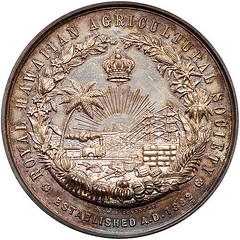

Hawaii. Royal Hawaiian Agricultural Society Silver Medal. Choice Uncirculated. Engraved on the reverse: "Premium for the Best Exhibited Imported Jersey Cow H. R. Macfarlane". 64 mm, 128.4 g, plain edge. Beautiful toning on both sides, and the obverse bears semi-reflective surface. Housed in the original wooden box as issued.
H. R. Macfarlane was the founder of Hawaiian Drayage and Supply Company (Foreign Office & Executive archive series 401 box 1 folder 3 document #34). He initially imported a Jersey cow from California in 1882, then in 1883 he imported a Jersey bull to breed (Planter's Monthly Volume V, 1886), and that was how he earned this medal. Besides Jersey Cow, he was also very successful in importing Durham bulls and cows to Hawaii from California and New Zealand.
The Royal Hawaiian Agricultural Society Medal is a silver medal which was issued by the Royal Hawaiian Agricultural Society, which was active in the Kingdom of Hawaii in the 1850s-on. The Society presented the medal annually to the best in each category of a juried exhibition of Hawaiian agricultural products. The earlier 1850-dated medals were produced at the United States Mint, while those carrying the 1882 issue date were struck in England, according the the Medcalf-Russell reference book on these. The number of specimens minted is unknown.
The obverse includes symbols of agricultural enterprise in the Hawaiian Islands -- sugar and coffee -- and implements and vehicles of trade -- the plow and tall ships; the eastern sun is rising in the background, with a palm to the left and royal crown above all. The inscription around the edge reads "Royal Hawaiian Agricultural Society. Established A.D. 1882." The reverse has a wreath surrounded by the inscription "Premium for the best exhibited" with a center field for prize category and awardee's name. The medal was engraved by Francis N. Mitchell. Estimated Value $8,000 - 10,000.
To read the complete lot description, see:
Lot 1745 of 4680: Hawaii. Royal Hawaiian Agricultural Society Silver
Medal. UNC (www.goldbergcoins.com/view-auctions/catalog/id/40/lot/87569/)
Lot 1747: 1883 Royal Hawaiian Agricultural Society Bronze Medal
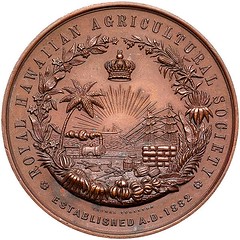

To read the complete lot description, see:
Lot 1747 of 4680: Hawaii. 1883 Royal Hawaiian Agricultural Society
Bronze Medal. UNC (www.goldbergcoins.com/view-auctions/catalog/id/40/lot/87570/)
Lot 1750: 1891 Hawaii Kahului Railroad Plantation Token
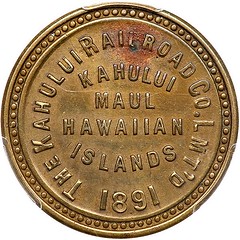
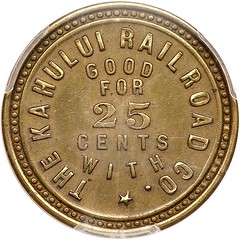
Hawaii. 1891 Hawaii, Plantation Token - Kahului Railroad 25 cents. PCGS graded About Uncirculated, Details, Environmental Damage. Struck in brass, 27 mm. An interesting Red Book type token, and slightly rarer than smaller denominations. The Kahului Railroad Co. Ltd was incorporated in July 1881, as the first and also the last railroad in the Kingdom of Hawaii, the company was firstly registered under the name of The Kahului and Wailuku Railroad. In 1884, it was sold to Wilder Steamship Co. and the new passenger cars were put into service in 1889. In 1891, a series of tokens of 10, 15, 20, 25, 35, and 75 cents were issued. The railroad operated until 1966. Estimated Value $3,000 - 3,500.
To read the complete lot description, see:
Lot 1750 of 4680: Hawaii. 1891 Hawaii, Plantation Token - Kahului
Railroad 25 cents. PCGS AU (www.goldbergcoins.com/view-auctions/catalog/id/40/lot/87574/)
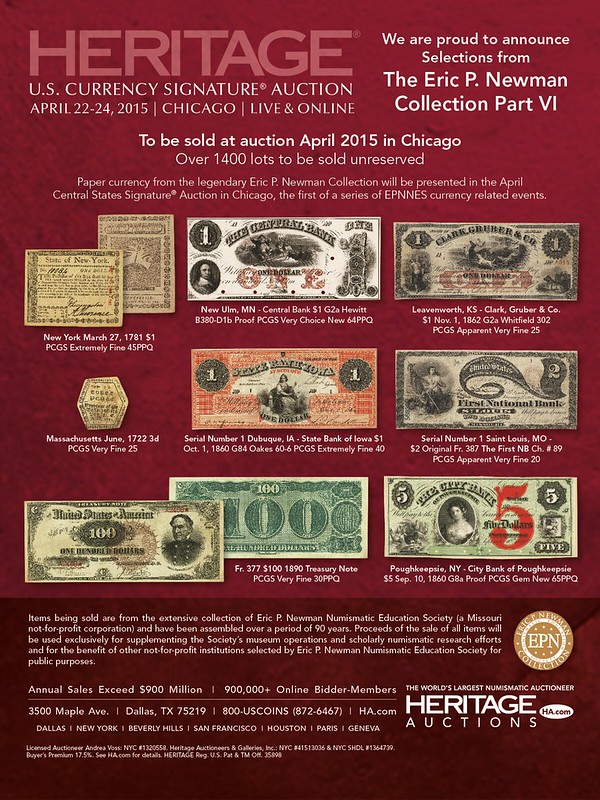
SELECTIONS FROM THE HAYDEN JANUARY 25 2015 SALE
1863 Turban Head Token Brockage Error
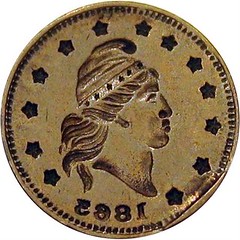
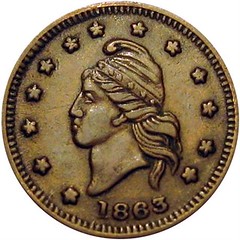
2 - 6/6 a R9 Raw EF 1863 Turban Head brockage mint error. From the Dave Bowers collection. (500-750)
To read the complete lot description, see:
2 - 6/6 a R9 Raw EF Brockage
Patriotic Civil War token (http://civilwartokens.com/Listing/Details/1449874/2-66-a-R9-Raw-EF-Brockage-Patriotic-Civil-War-token)
1861 Concession Before Secession Token
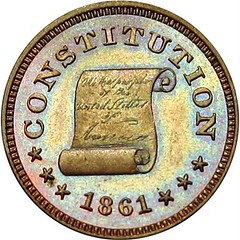

77 - 260/447 a R7 NGC MS65 BN Nicely toned. Constitution 1861 Concession Before Secession struck in Copper. A very popular token. We sold another NGC MS65 for $1,910 in our February 2014 auction. From the David Lucas collection. (1500-2000)
To read the complete lot description, see:
77 - 260/447 a R7
NGC MS65 BN Constitution 1861 Patriotic Civil War token
(http://civilwartokens.com/Listing/Details/1458625/77-260447-a-R7-NGC-MS65-BN-Constitution-1861-Patriotic-Civil-War-token)
J. WENZEL Counterstamp on 1863 Cent
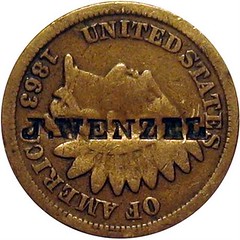
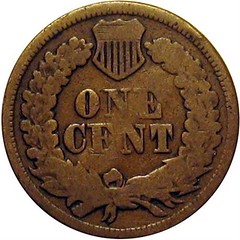
137 - IN715A-2d Unlisted Raw VF J. WENZEL counterstamped on the obverse of an 1863 Indian Head Cent. Although it was decided not to list this piece since it could have been struck after the Civil War, Steve kept it in his Indiana Civil War Token collection. From the Steve Tanenbaum collection earlier from Dave Schenkman at the 1974 ANA convention. (200-300)
To read the complete lot description, see:
137 - IN715A-2d
Unlisted Raw VF North Vernon Indiana Civil War Store Card
(http://civilwartokens.com/Listing/Details/1465621/137-IN715A2d-Unlisted-Raw-VF-North-Vernon-Indiana-Civil-War-Store-Card)
Brewer Counterstamp on 1834 Hard Times token

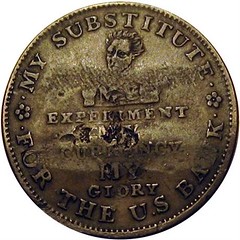
381 - R. A. BREWER / E. BREWER on the obverse of an 1834 Hard Times token HT-11. Raw EF Token VF. (50-75)
To read the complete lot description, see:
381 - R. A. BREWER /
E. BREWER on the obverse of 1834 Hard Times token HT-11
(http://civilwartokens.com/Listing/Details/1495013/381-R-A-BREWER-E-BREWER-on-the-obverse-of-1834-Hard-Times-token-HT11)
Charles Stubenrauch Medals Of All Kinds Coined
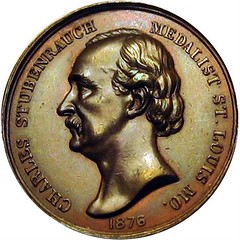
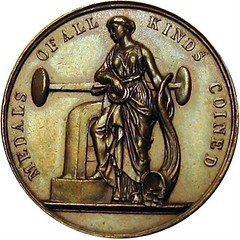
519 - RULAU Mo SL 32J Raw MS63 Trace Red all on the obverse. Charles Stubenrauch Medalist St. Louis MO. 1876 Medals Of All Kinds Coined with image of coin press on reverse. Struck in Copper with a Plain edge. A rare token, particularly this nice.
To read the complete lot description, see:
519 - RULAU Mo SL 32J Raw
MS63 St. Louis Missouri Merchant token
(http://civilwartokens.com/Listing/Details/1511040/519-RULAU-Mo-SL-32J-Raw-MS63-St-Louis-Missouri-Merchant-token)
SELECTIONS FROM THE JANUARY 2015 KÜNKER BERLIN AUCTION
Only ten more days until our Berlin Auction on January 29th, 2015. We are sure you have studied the catalog thoroughly. Today we want to introduce to you our German section. You will find some spectacular pieces. In particular, those who collect items from Saxony will discover a rarity or two. Learn more about Saxony with a film we have produced for you, and an article about one of its best-known rulers.
Lot 29: Reichstaler 1713
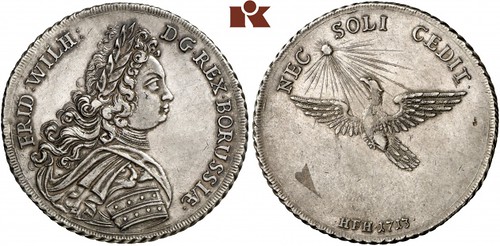
To read the complete lot description, see:
Friedrich Wilhelm I., der Soldatenkönig, 1713-1740. Reichstaler
(www.kuenker.de/en/auktionen/stueck/66010)
Lot 498: 1486 Guldiner

To read the complete lot description, see:
Erzherzog Sigismund, der Münzreiche, 1446-1496. Guldiner 148
(www.kuenker.de/en/auktionen/stueck/68912)
Lot 497: 1895 New Guinea 20 Mark

To read the complete lot description, see:
20 Neu-Guinea Mark 1895 A. J. 709. (www.kuenker.de/en/auktionen/stueck/66766)
To browse all of Künker auction #258, see:
https://www.kuenker.de/en/auktionen/auktions-uebersicht/258
ANCIENT COINS RETURNED TO GREECE FROM GERMANY

A total of 2,607 ancient coins seized on September 9, 2011, in the luggage of a Greek citizen travelling by car to Munich have been repatriated from Germany, according to a Greek Culture Ministry announcement.
Members of an antiquities smuggling criminal organization dismantled in March 2012 were involved in the case.
According to the announcement, most of the coins are made of cooper and date back to the Classical, Hellenistic, Roman and post-Roman period.
To read the complete article, see:
Repatriation of 2,607 Seized
Ancient Greek Coins From Germany - See more at:
http://greece.greekreporter.com/2015/01/24/repatriation-of-2607-seized-ancient-greek-coins-from-germany/#sthash.Vep1GRfD.dpuf
(http://greece.greekreporter.com/2015/01/24/repatriation-of-2607-seized-ancient-greek-coins-from-germany/)
THE BOOK BAZARRE
COUNTERFEITS OF 200,000 DONG VIETNAMESE BANKNOTES
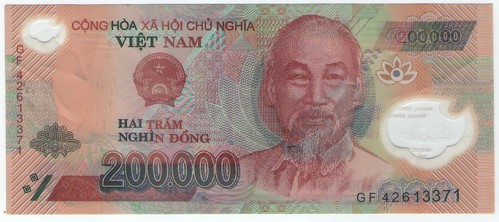
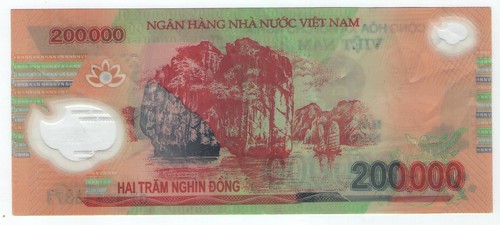
There is a new 200,000 Dong counterfeit variety which started coming into Viet Nam from China sometime last year. When I was shown my first one, it even had its printing shifted in several places. Look at the Hai Tram and Nghin Dong just above the 200.000 at the lower left in the attached image. It is a terrible note to try to pass but it did make it! And the polymer is also thicker.
Then I looked at the block, date and serial. The first two digits of what appears to be the serial number are actually the date. The latest date known to me is 11 for 2011. The counterfeit in the attached image has 42!! The counterfeiter did not realize there was a date on the note! I have also seen 37 as a date.
The number of these notes that has made it into Viet Nam must be significant because there is an article in the Ngan Hang (Banking) newspaper about the security features on the polymer notes. And I have seen posters on the doors of the local banks with small posters about the security features. I have two of these notes from circulation and trying to acquire more so Joe Boling can have at least one for his collection and to study them.
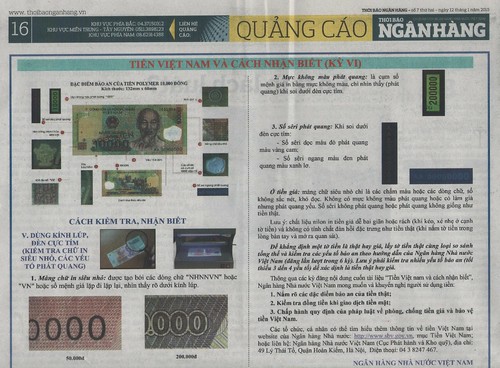
HOW HOLLYWOOD MAKES ITS MILLIONS (IN PROP MONEY)
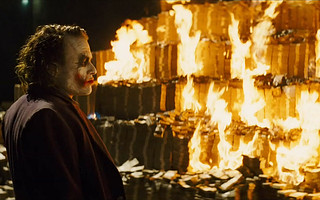 In a
world of contactless payment and online transfers, it sometimes feels as if “real” money – tangible, rustling cash – is disappearing altogether. But
this isn't the case in Hollywood, where massive stacks of paper banknotes remain one of the most enduring movie symbols of wealth and excess. No
one buys drugs or pays their hitman via credit card. The trope of the “briefcase full of cash” has cropped up so often, it’s now played as a joke: in
the opening credits of horror comedy Zombieland, a man desperately throws a briefcase of money into the air as he flees from two zombies. Perhaps
most striking of all are scenes in which huge amounts of money are treated with cavalier disrespect: think of Heath Ledger’s Joker setting fire to a
mountain of cash in The Dark Knight, or the TV series Breaking Bad, which memorably featured a scene in which characters recline on a huge pile of
notes.
In a
world of contactless payment and online transfers, it sometimes feels as if “real” money – tangible, rustling cash – is disappearing altogether. But
this isn't the case in Hollywood, where massive stacks of paper banknotes remain one of the most enduring movie symbols of wealth and excess. No
one buys drugs or pays their hitman via credit card. The trope of the “briefcase full of cash” has cropped up so often, it’s now played as a joke: in
the opening credits of horror comedy Zombieland, a man desperately throws a briefcase of money into the air as he flees from two zombies. Perhaps
most striking of all are scenes in which huge amounts of money are treated with cavalier disrespect: think of Heath Ledger’s Joker setting fire to a
mountain of cash in The Dark Knight, or the TV series Breaking Bad, which memorably featured a scene in which characters recline on a huge pile of
notes.
But what most people don’t think about when watching the on-screen clips of huge amounts of money, is that it’s actually pretty rare to see real banknotes on screen – and the world of fake movie cash is governed by strict laws.
Tim Lawes is manager at the movie collectibles company Propstore, which handles some of the fake banknotes used in films – including the bundles of notes used in The Dark Knight. Lawes explains that, while it is not illegal to film real money – although it is illegal to make like the Joker and destroy it – "realistic cash tends to be produced for filming for any number of practical reasons".
In the early days of Hollywood, counterfeiting laws prevented the use of real banknotes in film. But in 1920, when the Mexican revolution came to an end, large quantities of colourful – but worthless – Mexican currency hit the market, and were acquired by film studios looking for a realistic-ish substitute for US money. According to the website Paper Money of Sonora, the most common were the $5, $10 and $20 notes from the brilliantly named Banco del Estado de Chihuahua. When the real Mexican notes began to run out, studios began to produce their own mock-ups, based on the original designs (some of which featured the studio's name).
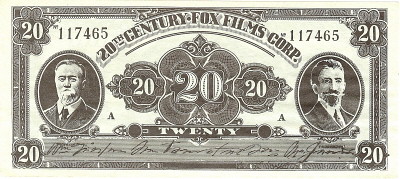
Later on, in the Seventies, filmmakers began to demand more realistic-looking money. But, when it comes to the manufacture of prop money, strict legal guidelines must be followed. US laws, for example, demand that fake cash be one-sided, and less than 75 per cent or more than 150 per cent the size of a real bill. In the UK, the Bank of England's guidelines also require prop notes to be one-sided and significantly larger or smaller than real notes. (They also demand that there should be "no distortion to the Queen's image".)
When it comes to movie prop collectors– rather than hopeful extras angling after some free money – lack of realism in a banknote can actually increase its appeal. Many banknotes are custom made for their respective films, often because the movie's plot requires a specific type of note. “Perhaps the story features a new king or president. Money will then be designed accordingly,” says Lawes. As an example, he points out that in Back to the Future II, banknotes featuring an arrogant-looking Biff Tannen (Thomas F. Wilson) were produced for the alternative version of 1985.
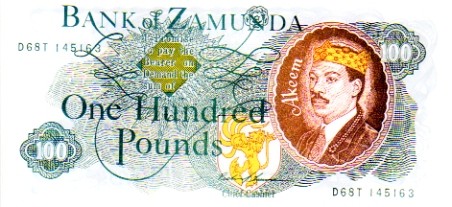
To read the complete article, see:
How Hollywood makes its millions
(www.telegraph.co.uk/culture/film/film-news/11357617/How-Hollywood-makes-its-millions.html)
MONEY LAUNDERING: NEW MACHINE CLEANS BANKNOTES
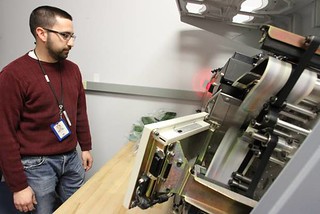 Spectra Systems Corp. announced Monday it has secured patents for machinery that will allow the world’s central banks to effectively clean currency
for reuse rather than paying billions of dollars each year to replace it.
Spectra Systems Corp. announced Monday it has secured patents for machinery that will allow the world’s central banks to effectively clean currency
for reuse rather than paying billions of dollars each year to replace it.
The patent protects Spectra as the pioneer of a process that relies on carbon dioxide, supercritical fluid and a money-cleaning machine that actually bears some resemblance to a laundry appliance.
Spectra’s machine and patented technique transforms grimy money — which doesn't meet the qualifications of central banks — into usable money.
Annually, the world's central banks shred roughly 150,000 tons of worn-out cash — about 150 billion notes — and spend almost $10 billion replacing the currency. Spectra also announced that it will have a machine ready for sale by March 31. The unit will clean up to 130,000 banknotes in one run and can clean up to 150 million notes per year, according to a news release.
As people handle currency, it attracts oil from skin, or sebum. The sebum yellows the notes and built-up sebum disqualifies the money under the standards of many central banks. It can also damage security features.
To read the complete article, see:
Providence company
patents banknote cleaning machine
(www.providencejournal.com/breaking-news/content/20150119-providence-company-patents-banknote-cleaning-machine.ece)

FAMILIES REUNITE WWI SOLDERS' MEDALS

Medals awarded to a group of Merseyside soldiers following a World War I battle were brought together by three generations of descendants for the first time in almost a century.
A total of 12 Royal Field Artillery soldiers from D Battery of the 276th (West Lancs) Brigade were recognised for their brave actions on November 30, 1917 during the Battle of Cambrai in France.
 At
the headquarters of the Royal Artillery 208 battery in Aigburth this week his medal was brought up from the Royal Artillery Museum, along with four
others brought by relatives of fellow members of the battery.
At
the headquarters of the Royal Artillery 208 battery in Aigburth this week his medal was brought up from the Royal Artillery Museum, along with four
others brought by relatives of fellow members of the battery.
They included a Distinguished Conduct Medal awarded to Sgt Edward Thornley from West Derby and Military Medals awarded to Gnr Frederick Backhouse, Bdr Joseph Pinnington and Gnr Reginald Evans.
The emotional event came about after three Wirral families got in touch as a result of an Armistice Day event at Calday, where the VC was paraded last November.
Afterwards Pat Metcalfe said: “We felt very much our fathers and grandfathers must have got on, because we all get on so well and all feel at ease with each other, which is great.
“It’s been really emotional.”
To read the complete article, see:
Medals of Mersey war heroes brought together for first time in
almost a century (www.liverpoolecho.co.uk/news/medals-awarded-mersey-world-war-8494375)
To read the earlier E-Sylum article, see:
FAMILIES TO REUNITE WWI SOLDERS' MEDALS
(www.coinbooks.org/esylum_v18n01a21.html)
COIN COMMEMORATES POPE'S VISIT TO SRI LANKA
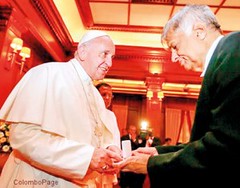 At the request of the Sri Lanka Catholic Bishop’s Conference a commemorative Rs. 500 sterling silver
crown size frosted Proof Non-circulating Legal Tender (NCLT) coin was issued by the Central Bank of Sri Lanka (CB) to mark the visit of Pope Francis
from January 13 to 15th . It is the first commemorative coin issued by CB, in recognition of a Christian religious event.
At the request of the Sri Lanka Catholic Bishop’s Conference a commemorative Rs. 500 sterling silver
crown size frosted Proof Non-circulating Legal Tender (NCLT) coin was issued by the Central Bank of Sri Lanka (CB) to mark the visit of Pope Francis
from January 13 to 15th . It is the first commemorative coin issued by CB, in recognition of a Christian religious event.
The coin was presented to the Pope Francis by Prime Minister Ranil Wickremesinghe at an event hosted by President Maithripala Sirisena at the Presidential Secretariat in Colombo.
Obverse : In the centre is an image of Pope Francis. Within a circle of 120 dots is a ring of 33 honeysuckle flowers in the traditional Sinhala artistic style. Number 33, is considered a sacred number in the Christian tradition, based on the estimated lifetime of Jesus Christ.
Reverse: In the centre is the official logo for the visit. The periphery is decorated with a Liywela made out of 40 floral designs each with Na flowers, 3 Na buds and 3 Na leaves, within a circle of 120 dots. Na, the National Tree of Sri Lanka, is used in the statue of Our Lady of Lanka – representing the Blessed Virgin Mary, the mother of Jesus Christ.
The coin was designed by Rev. Fr. Priyantha Silva, Archdiocesan Consultant on Ecclesiastical Arts and Architecture.
This limited edition of 1500 coins was made at Mincovna Kremnica in Slovak Republic with one ounce of sterling silver to the Buddha Jayanthi Rs. 5 silver coin size. Enclosed in a circular coin capsule, it is embedded in red velvet inside a white leatherette covered 6.5cm square spring hinged presentation box with white satin inside cover. A printed numbered Certificate of Authenticity contains the specifications and the text in English, Sinhala and Tamil. The frosted proof coin should never be removed from capsule and touched by hand as finger prints will ruin the numismatic value.
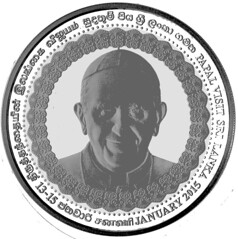

To read the complete article, see:
Silver coin to commemorate
Papal visit to Sri Lanka (www.sundaytimes.lk/150125/business-times/silver-coin-to-commemorate-papal-visit-to-sri-lanka-131519.html)
For more information on Kavan's web site, see:
2015 - Pope Francis Visit SRI LANKA - 500 Rupee
(http://coins.lakdiva.org/commemorative/2015_popefrancisvisit_500r.html)
THE COIN BUSINESS: ADAPT OR DIE
The 2015 FUN Show: Let's Put it in Perspective
One of the good things about filing a show report a week after the event ends is – it affords me some distance and perspective. I came away quite pleased with the results of my first FUN show on my own in this new solo iteration of my coin business (it is actually the 10 billionth FUN show I have set up at – no exaggeration ... er, maybe I exaggerated a tiny bit … ).
In contrast, a lot of the experienced dealers I spoke with at the show lamented that the show – indeed, pretty much ALL of the major national coin shows in the past few years – are not what they used to be. No fresh deals come in; the serious customers were fewer in number; the auctions soak up much of the dollars being spent that week. And so on.
When the third or fourth dealer complained to me about this state of affairs during the show, I started thinking to myself, “Well, I've got news for you, Chuckles. The old days? They aren't ever coming back. This is the new reality of coin shows.”
My expectations have simply changed with regard to coin shows. They had to. The marketplace has shifted.
The coin business is bigger than it ever has been at any time in history. It's just that the locus of activity is no longer big shows. It is now the Internet, and that includes the huge auctions that are largely conducted online these days.
Heck, I would love to turn the clock back to the way it was. Those were the days. The major auctions had only raw coins so true numismatist buyers got the great deals, and all the “trap” coins were bought by the unknowledgeable. You would set up at a show and dealers like me would be offered all kinds of fresh coins and fresh collections. But that was the past and this is now.
“You can’t reach for anything new if your hands are still full of yesterday’s junk.” - Louise Smith
One of my favorite coin dealers has a saying that sums up his entire business philosophy. It is: “Adapt or die.”
He has been in the coin business since the late 1970's. He has seen several booms; he has seen several busts. He told me he came close to going out of business in the lean years of the early 1990's. But he hung on, and he has thrived in a big way since then.
His business has been through many iterations over the years. I'm sure it would be largely unrecognizable to him from the vantage point of his earlier self.
That is the key to success in the coin business these days. And with that in mind, dealers must have realistic expectations and goals for these major shows, and find a way to still make them work. Plenty of dealers on the national show have already made these adjustments, and are doing just fine. For those who can't – well, it's been a good ride, I'm sure.
To read all of Dave's newsletters, see:
www.davewcoins.com/newsletter
THE BOOK BAZARRE
SHIP'S COINS DELIVERED BY BUTLER IN A ROLLS-ROYCE
 Fincantieri laid the first piece of steel for Regent Seven Seas Cruises’
(RSSC) newbuild at its yard in Genoa, Italy, on 21 January.
Fincantieri laid the first piece of steel for Regent Seven Seas Cruises’
(RSSC) newbuild at its yard in Genoa, Italy, on 21 January.
The ceremony marked a significant milestone in Seven Seas Explorer’s construction, bringing the ship closer to July 2016 debut.
During the ceremony, a black Rolls-Royce Phantom transported three symbolic coins to the keel laying event, before they were placed on a pillow by a butler and carried to the ship.
The coins included a rare 1921 US silver coin known as the Peace Dollar, which symbolises the safe passage of Seven Seas Explorer; a 1959 silver Italian Lire representing the year the Fincantieri shipyard was established; and a commemorative coin specially minted for the occasion.
All three coins were welded into the newbuild’s keel by Jason Montague, president and COO of Regent Seven Seas Cruises; Robin Lindsay, executive vice president of vessel operations; and Franco Semeraro, senior vice president of hotel operations. The building block was then lowered into the dry dock.
Earlier this month, RSSC revealed Seven Seas Explorer is to offer the line’s first 3,875 sq ft suite, as well as lounges, gourmet restaurants and more.
To read the complete article, see:
Fincantieri lays the keel for
Regent Seven Seas newbuild (www.cruiseandferry.net/articles/Fincantieri-lays-the-keel-for-Regent-Seven-Seas-newbuild#.VMQ-N_4VhYE)
To read the earlier E-Sylum articles, see:
STEPPING THE MAST IN CHARLESTON, SOUTH CAROLINA
(www.coinbooks.org/esylum_v10n17a15.html)
STEPPING THE MAST: COINS OF THE BLUENOSE II (www.coinbooks.org/esylum_v14n02a20.html)
STEPPING OF THE MAST: MADDIE JAMES' FAVORITE COIN
(www.coinbooks.org/esylum_v16n16a26.html)
STEPPING THE MAST OF THE WHALING SHIP CHARLES W. MORGAN
(www.coinbooks.org/esylum_v16n43a25.html)
KAMPMANN JOINS BERMANIAN GUILD OF NUMISMATISTS
There is a small kingdom located in the remote corners of the Balkans. It is an age-old kingdom that was founded a long time ago, at some point during the Byzantine Empire. The Kingdom of Bermania is ruled by Alanus I who, with a gentle hand, promotes both humor and numismatics.
Alanus I, for reasons of necessity – with only a few coin collectors living in the secluded valley, in the remote corners of the Balkans, and with King Alanus not levying taxes and hence depending on his bread-and-butter job as a numismatist… - has retreated to a place near the city of New York. That is why the famous meetings of Be.G.O.N., the Bermanian Guild of Numismatists, where in the past more than one certainty of traditional numismatics have crumbled into dust, are often held alongside the New York International Numismatic Convention.
In 2015, as every year, the Bermanic people and a couple of invited guests gathered to listen to the royal speech and to receive a largitio that stood in the tradition of Roman-Byzantine customs. In Bermania, the largitio traditionally consists of baklava that, thankfully, is not thrown into the crowd but presented by the crown prince neatly on a plate.
 This
year’s speech of His Royal Highness addressed a hitherto unknown manuscript of the author Marc Twain in which he reported on the trip to Bermania
that he undertook to get some breeding pairs of the American opossum to the then Bermanian King. On his trip he realized that the opossums found
approval not as an asset to the European zoos but were rather acquired by the distinguished zoo directors to make their gorgeous beards look even
prettier. Please note: he who has an opossum in his beard will not run short of original topics of conversation at any party!
This
year’s speech of His Royal Highness addressed a hitherto unknown manuscript of the author Marc Twain in which he reported on the trip to Bermania
that he undertook to get some breeding pairs of the American opossum to the then Bermanian King. On his trip he realized that the opossums found
approval not as an asset to the European zoos but were rather acquired by the distinguished zoo directors to make their gorgeous beards look even
prettier. Please note: he who has an opossum in his beard will not run short of original topics of conversation at any party!
Mark Twain likewise crossed the native city of the former citizen of Bermania, Munich. The Royal academic elaborating on this stop can certainly be taken as an homage to Ursula Monacensis Burgcomitissa, as Ursula Kampmann was welcomed into the Kingdom of Bermania by King Alanus in his 41st year of reign.
 In a long and elaborate swearing-in ceremony Ursula Kampmann was proclaimed Burgravine of Munich. She
took an oath to rule wisely and justly in the name of Bermania.
In a long and elaborate swearing-in ceremony Ursula Kampmann was proclaimed Burgravine of Munich. She
took an oath to rule wisely and justly in the name of Bermania.
In his non-royal everyday life His Majesty Alanus I is a coin dealer with a passion for selling coins that tell a story. His website is linked here.
As a coin dealer he has written several books, including “Papal Coins”“ and “Papal Numismatic History”, which can be bought directly from him – with a royal dedication, if requested.
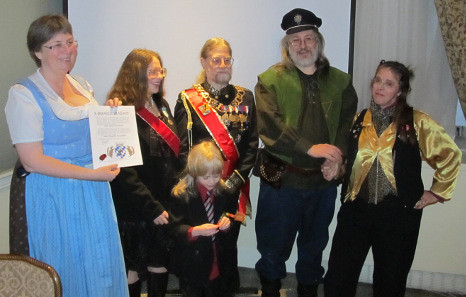
The Bermanian Royal Court posing with the newly-appointed Burgravine.
To read the complete article, see:
The Kingdom of Bermania (www.coinsweekly.com/en/News/4?&id=3219)
ORIGAMI FISH MADE FROM A DOLLAR BILL
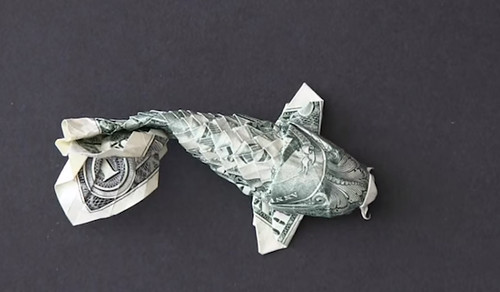
To watch the video, see:
Folding Won Park's Dollar Koi (www.youtube.com/watch?v=a5YbAecdhdk)
FEATURED WEB SITE: PAPER CURRENCY OF CHIHUAHUA
This week's Featured Web Site is Simon Prendergast's site on the paper currency of Chihuahua, Mexico.Welcome to this website, which is the result of over twenty years' research into the paper currency of the Mexican state of Chihuahua. A companion website is dedicated to the neighbouring state of Sonora.
The history of the paper currency of Chihuahua is a complex subject, covering a period of just under 100 years. It begins with the scrip issued by private companies in the second half of the 19th century , includes the various local banks of issue and the numerous issues of different revolutionary factions, and ends with the emergency notes issued to deal with a temporary shortage of low-denomination coins in 1935 and 1943.
Chihuahua is the largest state in Mexico and until the Revolution was the most prosperous with an economy based on its agricultural riches and mineral deposits. It is not surprising therefore that this is reflected in the paper currency issued in the state.
After the Revolution Mexico established a single bank of issue but local banks and chambers of commerce were on two occasions permitted to make short-term issues to counteract a temporary shortage of small change.
For the purposes of this website “paper currency of Chihuahua” has been defined rather loosely as including any item that is
(a) printed on paper or a similar medium;
( (b) negotiable, and usually payable to bearer;
( (c) for a particular discrete amount, and
( (d) proceeding from within the state of Chihuahua

http://papermoneyofchihuahua.com
